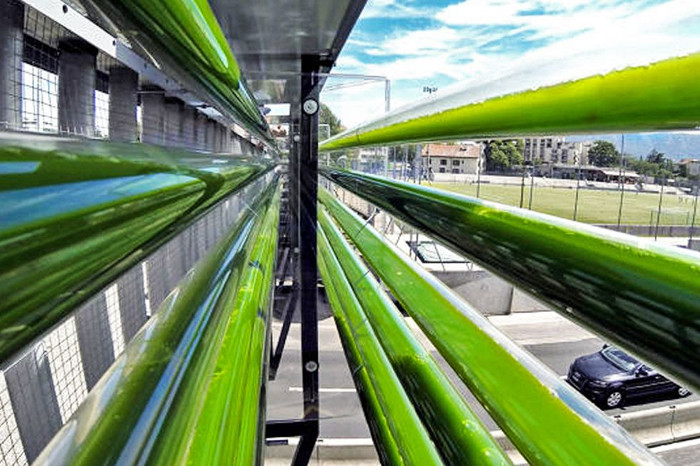With these 6 projects, air pollution will not be scary
Architectural works Vertical forests in Milan (Italy) have inspired many designers around the world and similar projects with smaller scale are also actively working to combat re-process air pollution.
Air pollution is a big problem for any city in the world. The use of fossil fuels as fuel in combination with indiscriminate deforestation has increased the concentration of smoke in large urban centers.

Air pollution is becoming a problem today.
According to World Health Organization estimates, air pollution is the culprit that is killing 7 million people every year. An alarming number! And to solve this community-related problem, architects from all over the world have designed many interesting (and somewhat crazy) works and utilities to contribute to clean atmosphere.
High-speed flyover Geneva uses algae to purify emissions
Switzerland has traditionally pursued green and clean technology. Therefore, it is not surprising that there is an overpass that is able to clean the air, turning dust and smoke from vehicles into materials for photosynthesis of autotrophic photosynthetic organisms.
Cloud Collective - the French and Dutch design team "planted" an algae garden in transparent tubes attached to the side of the Geneva highway overpass. What is special is that this algae is capable of absorbing carbon emissions from vehicles passing through here, thus helping the environment more healthy.

Geneva highway overpass.
Wendy flower at MoMA PS1 museum
Every year, the Summer Warm Up series brings the most impressive designs and many of them focus on improving the environment. An installation work combining technology called Wendy of HWKN (USA) is considered a highlight in MoMA PS1 area . This is the winning design in the 13th Young Architecture Program of MoMa PS1 - the contest to encourage emerging architecture companies.
Wendy is made of available materials, protected by a giant scaffolding frame. Wendy was covered in blue nylon fabric that formed the shape of spikes protruding like wings of stars. Nylon fabric can spray titanium nanoparticles (TiO 2 ) molecules to reduce air pollution. Star tips are fitted with cool blowing equipment, playing music, spraying, water gun shooting . to help summer weather become cooler. It is estimated that in about 3 months, Wendy is able to filter emissions of 260 cars.

This giant flower has a rather funny shape.
Wendy's design is based on new technology, using environmental cleaners, and this is also a funny figure. This is really a work worth watching when coming to MoMA PS1.
Air purifiers turn dirt into gems
Last fall, it was thanks to the public fundraising model that Daan Roosegaarde - the Dutch designer created the world's largest vacuum cleaner . This air purifier was created with the main purpose of helping parks and cities escape dust pollution.

This machine is actually a 7 meter high tower.
This 7-meter-high machine is capable of filtering about 30,000 cubic meters of gas per hour. As a larger version of the family air purifier, Roosegaarde's machine also uses an ion filter to remove pollution, create ultra-clean air bubbles in public places, such as parks, then condensing dust in the air into a gem that can be used to make jewelry. It is the project contributors who will receive the jewelry created from these gems.
The vertical forest on the skyscraper in Italy
Bosco Verticale Twin Towers (vertical forest) is an excellent architectural solution to solve the problem of environmental pollution in densely populated urban areas. Built in Milan since 2014, this skyscraper consists of 113 apartments, all balconies are used to plant trees with a total area of up to 2.5 acres. More than 21,000 trees planted on the building contributed to the fresh air by absorbing excess carbon dioxide and releasing oxygen. In addition, the foliage also helps reflect the sound of engine and honking, thereby contributing to reducing noise pollution.

Bosco Verticale.
Roof tile absorbs contaminants
Another smart idea is to contribute to the air cleaning developed by a group of students at California Riverside University. These are tiles coated with titanium dioxide that oxidize air pollutants in sunlight and turn them into harmless calcium nitrate. The group of students was also supported by the Environmental Protection Agency with US $ 15,000 to continue researching and creating products that are capable of absorbing pollutants.

These tiles are coated with titanium dioxide, which absorbs contaminants.
The road filters dust
Before the University of California Riverside student group came up with the idea of a titanium dioxide tile roof, a group of Dutch scientists tested the same solution for the road surface.

The road surface has the ability to filter dust and smoke.
The pavement is coated with a photocatalyst layer, which helps reduce about half the concentration of dust in the air. The use of titanium dioxide in the streets to reduce air pollution is a method that seems to be very effective even in a very short time.
Because the method is quite expensive, it is difficult to create a revolution in urban roads, but anyway, this technology has some useful applications.
- Growing wild plants, Beijing turned into a huge pollution trap?
- Chinese aluminum factory pollutes the environment
- The campaign hunts for black, stinking rivers in China
- The story behind Apple's secret project code names
- Unexpected culprit causes scary air pollution in China
- Air pollution causes 7 million deaths
- Renovating the management mechanism of programs, projects, science projects and state-level branches
- 1.2 million Chinese people die from air pollution
- China spent 277 billion USD to solve the problem of pollution
- China wants to keep the right to publish pollution indicators
- 7 'Unbelievable' science projects of the US Department of Defense
- Beijing uses rain to wash away contaminated smoke
 Is the magnetic North Pole shift dangerous to humanity?
Is the magnetic North Pole shift dangerous to humanity? Washington legalizes the recycling of human bodies into fertilizer
Washington legalizes the recycling of human bodies into fertilizer Lightning stone - the mysterious guest
Lightning stone - the mysterious guest Stunned by the mysterious sunset, strange appearance
Stunned by the mysterious sunset, strange appearance